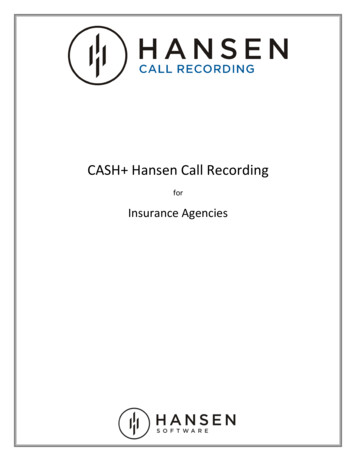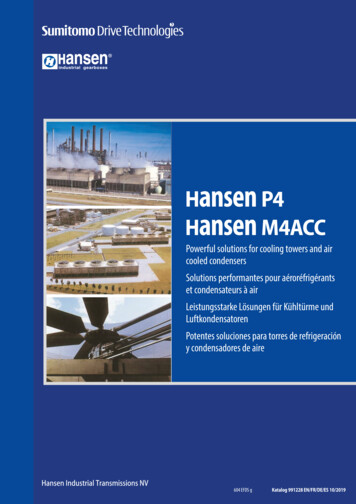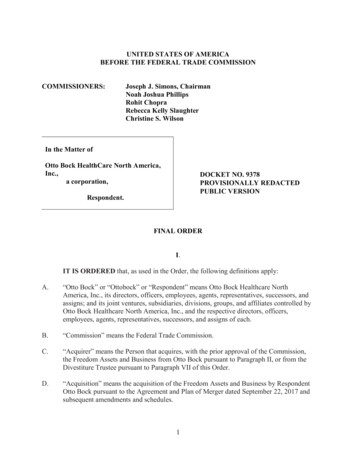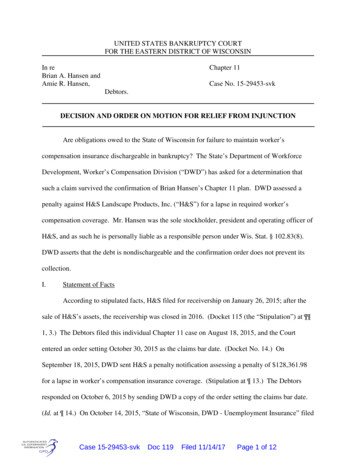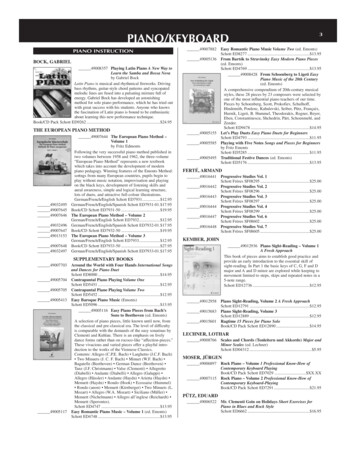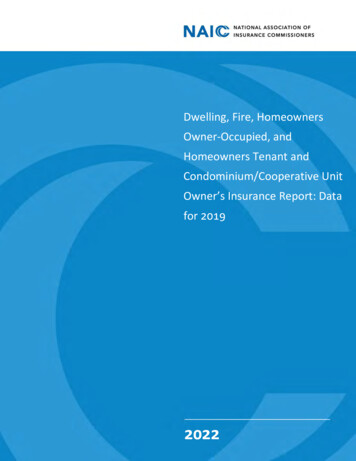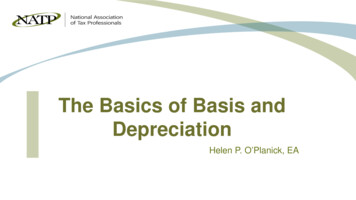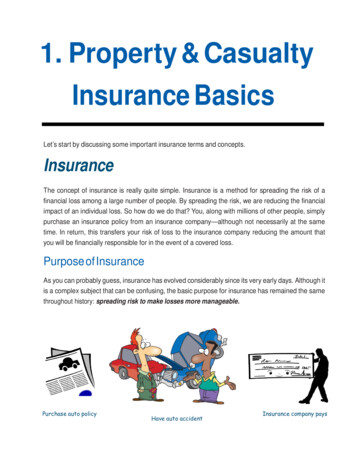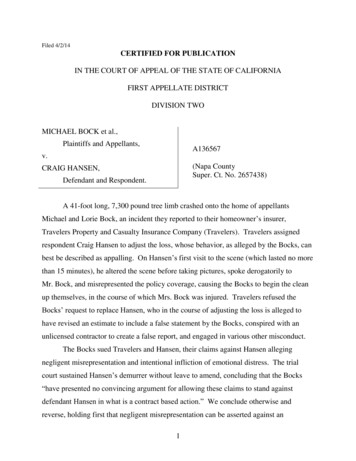
Transcription
Filed 4/2/14CERTIFIED FOR PUBLICATIONIN THE COURT OF APPEAL OF THE STATE OF CALIFORNIAFIRST APPELLATE DISTRICTDIVISION TWOMICHAEL BOCK et al.,Plaintiffs and Appellants,A136567v.(Napa CountySuper. Ct. No. 2657438)CRAIG HANSEN,Defendant and Respondent.A 41-foot long, 7,300 pound tree limb crashed onto the home of appellantsMichael and Lorie Bock, an incident they reported to their homeowner’s insurer,Travelers Property and Casualty Insurance Company (Travelers). Travelers assignedrespondent Craig Hansen to adjust the loss, whose behavior, as alleged by the Bocks, canbest be described as appalling. On Hansen’s first visit to the scene (which lasted no morethan 15 minutes), he altered the scene before taking pictures, spoke derogatorily toMr. Bock, and misrepresented the policy coverage, causing the Bocks to begin the cleanup themselves, in the course of which Mrs. Bock was injured. Travelers refused theBocks’ request to replace Hansen, who in the course of adjusting the loss is alleged tohave revised an estimate to include a false statement by the Bocks, conspired with anunlicensed contractor to create a false report, and engaged in various other misconduct.The Bocks sued Travelers and Hansen, their claims against Hansen allegingnegligent misrepresentation and intentional infliction of emotional distress. The trialcourt sustained Hansen’s demurrer without leave to amend, concluding that the Bocks“have presented no convincing argument for allowing these claims to stand againstdefendant Hansen in what is a contract based action.” We conclude otherwise andreverse, holding first that negligent misrepresentation can be asserted against an1
insurance adjuster, and that such claim was adequately pleaded here. We also hold thatthe intentional infliction of emotional distress claim was not adequately pleaded, but thatthe trial court abused its discretion in denying leave to amend.1BACKGROUNDThe FactsThe facts for our analysis are those alleged by the Bocks, all of which are admittedby Hansen’s demurrer (Aubry v. Tri-City Hospital Dist. (1992) 2 Cal.4th 962, 966-967),as are any facts that may be implied or inferred from those expressly alleged. (TradersSports, Inc. v. City of San Leandro (2001) 93 Cal.App.4th 37, 43.) Those facts must beaccepted no matter how unlikely or improbable (Del E. Webb Corp. v. StructuredMaterials Co. (1981) 123 Cal.App.3d 593, 604), and without regard to the Bocks’ abilityto prove them. (Committee on Children’s Television, Inc. v. General Foods Corp. (1983)35 Cal.3d 197, 213-214.) Those facts are these:In December 2001, the Bocks purchased from Travelers a homeowner’s policycovering their home in the city of Angwin, Napa County. The policy covered certainrisks of physical loss to their home and provided additional coverage for debris removal.Early on the morning of September 9, 2010, a large limb—41 feet long, some twofeet in diameter, and weighing 7,300 pounds—broke off from an oak tree in the Bocks’front yard, “crashing into the chimney, the front of the house, and through the livingroom window.” The giant limb caused three other large limbs to fall, which came to reston a portion of the Bocks’ chimney. The limbs “caused significant damage to the Bocks’chimney, which had been in working condition prior to the incident and was used as the1This case was argued on January 22, 2014, and submitted that day. Today,April 2, 2014, the day the opinion is filed, the clerk’s office received a letter from counseladvising that the parties have settled and enclosing a stipulation for dismissal of theappeal. We do not have to accept such stipulation. (See Cal. Rules of Court,rule 8.244(c)(2).) And we do not, especially in light of the issues presented. (BayGuardian Co. v. New Times Media, LLC (2010) 187 Cal.App.4th 438, 445, fn. 2;Castro v. Superior Court (2004) 116 Cal.App.4th 1010, 1014, fn. 3; DVD Copy ControlAssn., Inc. v. Bunner (2004) 116 Cal.App.4th 241, 245, fn. 2.)2
Bocks’ primary heating source for their home.” The limbs also broke three windows andcaused damage to the interior of the home, the Bocks’ fence, and Mrs. Bock’s car.The Bocks reported the incident to Travelers that same day. Travelers did notsend an adjuster to the scene until the following day, September 10, when Hansenarrived. Upon arrival, Hansen told Mrs. Bock that he only had a few minutes to reviewthe damage, and in fact spent no more than ten to fifteen minutes at their home. BeforeHansen took any pictures of the damage, he pushed several branches out of the livingroom window. When Mrs. Bock asked Hansen why he had not taken the pictures first, heignored her, telling her to “clean up the mess,” and demanding she clean up the livingroom. Moving outside, Hansen also removed the limbs leaning against the chimney andthe fence before taking any pictures, all the while making derogatory comments aboutPG&E, Mr. Bock’s employer, which Mrs. Bock found rude and upsetting.Before leaving, Hansen wrote a check for 675.69. When Mrs. Bock said that theamount would not be enough to even clean up, let alone repair, the damage, Hansen toldher that cleanup was not covered under the policy and that she should contact “friendsand family members with chainsaws” to clean up the limbs and the mess in the house andbackyard. Relying on these statements, Mrs. Bock attempted to clean up the brokenglass, sustaining a cut on her hand.After Hansen left, Mr. Bock discovered that the fallen limbs had caused significantdamage to the chimney. The next day, September 11, Mrs. Bock sent an email toTravelers Property Field Manager Frank Blaha, reporting the chimney damage. She alsorequested that another adjuster be assigned to their claim because Hansen was “rude,disinterested, and rushed during his initial visit.”Travelers ignored the request, and Hansen prepared an estimate, which Blaha sentto the Bocks on September 13. The estimate, which totaled 3,479.54 , reflected minimalamounts for each category of repairs needed, and was unreasonably low, as the Bockshad obtained an estimate the same day in the amount of 2,065 for cut up and removal ofthe tree limbs alone.3
On September 15, Hansen again came to the house, this time accompanied byBlaha. The Bocks were present, as was Ron Priest, a licensed general contractor whowas there at the Bocks’ request. Hansen and Blaha were shown the significant cracks inthe chimney, as well as gouges where the limbs had hit it, and Hansen took pictures ofthe damage to the chimney. Again, Hansen falsely told the Bocks that their policy didnot cover the cost of clean up, explaining, “If a car had hit the tree causing it to fall, thenthe clean-up would be covered but since the wind caused the limb to fall, the cost to cleanup the limbs was not covered.” Hansen told Mr. Bock to get his chainsaw and removethe limbs himself, and as he did so, Hansen yelled, “Atta boy! See you can do it! Nowgo get a few friends to finish it up.”On September 17, Travelers provided the Bocks with a revised estimate for theloss. While the revised estimate increased the amount payable to 3,655.23, it eliminatedamounts previously included for damage to the hardwood floor and fence, based on thefalse statement that the Bocks had confirmed during the reinspection that there was nodamage to those items, despite obvious physical evidence to the contrary.That same day, acting at the request of Travelers, Roy Anderson of VertexConstruction Services (Vertex) inspected the Bocks’ house. Neither Vertex norAnderson had a valid California contractor’s license. Because the limbs and debris hadalready been removed, Mrs. Bock provided Anderson a disk containing digital imagesthat showed the fallen limbs and damage on the morning of the accident. Anderson sentHansen a report dated September 29, detailing the results of his inspection and whichconcluded—falsely, the Bocks alleged—that “[n]o scarring, gouging, or scuff marks werenoted on the siding or trim materials on the northeast corner of the residence.”Anderson’s report also falsely stated that “[t]here was no visual evidence that the fallentree branch impacted the chimney, or that the fallen tree branch . . . propagated anydamage to the natural rock chimney,” instead concluding that the “fireplace appear[ed] tobe in good and serviceable condition.” Finally, Anderson’s report concluded that theobserved cracks in the chimney were minor and were “due to the age of the chimney andthe residence,” and that inspection of the interior and exterior of the house revealed that4
“[t]he only damage . . . due to the fallen tree branch [was] the broken window andframe.” Hansen did not perform any tests to support his conclusion, and did not includein his report any statements from the Bocks or Priest.By letter dated October 1, Hansen informed the Bocks that based on the Vertexreport Travelers was denying coverage for the chimney damage.The Bocks asked Priest, a licensed contractor, to review the Vertex report andprovide a response. He did, preparing a report disputing the false statements contained inthe Vertex report and describing how the tree limb damaged the chimney, a conclusion hereached having inspected the property three times. On January 14, 2011, the Bocks,through their attorney, submitted additional information to Travelers, including Priest’sreport, and requested that Travelers reconsider its coverage determination. Travelersnever responded.The Proceedings BelowThe Bocks filed a complaint naming Travelers, Hansen, and Vertex. Thecomplaint asserted six causes of action, including five against Travelers, styled asfollows: first, breach of contract; second, breach of the implied covenant of good faithand fair dealing (bad faith); third, intentional misrepresentation (false promise with nointent to perform); fourth, intentional misrepresentation (false statement); and sixth,violation of Business and Professions Code section 17200 et seq. The fourth cause ofaction, for intentional misrepresentation, was also alleged against Hansen. Two causes ofaction, the fifth, for intentional interference with contract, and the sixth, were allegedagainst Vertex.2Travelers demurred to the third, fourth, and sixth causes of action on the groundthat each failed to state a claim. Travelers also filed a motion to strike all allegations thatit acted with malice, oppression, and fraud, and all requests for punitive damages andattorney fees. As to the third cause of action, promise without intent to perform,2Vertex answered the original complaint, as well as the first amended complaint ,and its involvement is not pertinent to the issues before us.5
Travelers argued that the complaint failed to allege any facts demonstrating that Travelersnever intended to perform under the terms of the policy at the time it was issued to theBocks. As to the fourth cause of action, false statement, Travelers argued that thecomplaint failed to allege the specificity required of a fraud claim, and was an improperattempt by the Bocks to turn a contract dispute into a fraud claim. And as to the sixthcause of action, violation of Business and Professions Code section 17200, Travelersargued that the Bocks failed to identify a California law that Travelers allegedly violatedand failed to allege conduct that was unfair or fraudulent, since a section 17200 claimcannot be based on mere claims mishandling.The First Amended ComplaintBefore Travelers’ demurrer came on for hearing, the Bocks filed a first amendedcomplaint (FAC). They withdrew their claim for intentional misrepresentation based ona false statement, but added claims for negligent misrepresentation (fourth cause ofaction) and intentional infliction of emotional distress (a new fifth cause of action). Bothclaims were alleged against Travelers and Hansen, and are the causes of action involvedin this appeal.The fourth cause of action, negligent misrepresentation, alleged that Hansenfalsely told the Bocks that their policy did not cover the cost of clean up; that Hanseneither knew the representations were false when he made them, or he made them withreckless disregard of their truth; and that the Bocks relied on Hansen’s false statementsand performed the cleanup on their own, to their detriment.The fifth cause of action, intentional infliction of emotional distress, alleged thatthe actions of both Travelers and Hansen were extreme and outrageous and were knownby them to be substantially certain to cause the Bocks significant distress. In support ofthis allegation, the Bocks asserted that defendants abused their position of power overthem to falsely induce them to perform the cleanup; purposely ignored informationdemonstrating coverage when they denied the claim; and withheld information fromVertex when the chimney was inspected—all to “justify [defendants’] predeterminedcourse of denying payments justly due to [the Bocks] under the policy.”6
Travelers again demurred to all causes of action except for the breach of contractand bad faith claims. Travelers’ fundamental argument was that the causes of actionwere all premised on Travelers’ alleged mishandling of a claim, and was in essence adispute properly asserted only as claims for breach of contract and bad faith. Travelersalso filed another motion to strike, again seeking to strike all allegations of malice,oppression, and fraud, and all requests for punitive damages and attorney fees.Following the Bocks’ opposition, and Travelers’ reply, the demurrer and motion tostrike came on for hearing on March 13, 2012. Ten days later, the court issued its brief,four-paragraph ruling, sustaining the demurrer without leave to amend. The substance ofthe order reads in its entirety is as follows:“Defendant’s demurrer to the causes of action for intentional and negligentmisrepresentation, intentional infliction of emotional distress and unfair businesspractices is SUSTAINED, without leave to amend.“It is clear from the allegations, and from the arguments made in plaintiffs’opposition, that this action is strictly contract based. None of the facts alleged in the[First Amended Complaint] support a fraud based claim, and plaintiffs have notsuggested any facts they could allege that would support a misrepresentation claim or aclaim for intentional infliction of emotional distress. Because none of these causes ofaction are [sic] supported, there is also no basis to include a claim for unfair businesspractices.“The court notes that plaintiffs previously amended their complaint in response toa demurrer raising these same arguments as to fraud claims in the original complaint.Because plaintiffs have not successfully cured the defects noted in that earlier demurrer,and have not set forth facts and argument suggesting that the defects can be cured, thecourt will sustain the demurrer to the subject causes of action without leave to amend.”The court also granted Travelers’ motion to strike, again without leave to amend,explaining in full as follows: “Defendant’s motion to strike plaintiffs’ claims for punitivedamages and for private attorney general attorney’s fees is GRANTED, without leave toamend. As noted above, the court sustains without leave to amend all causes of action7
upon which plaintiffs’ claims for punitive damages and attorney’s fees rest. The FACsimply contains no allegations to support these claims, and the court finds no basis forallowing leave to file a second amended complaint.”3The court ordered Travelers to answer the remaining causes of action within tendays, which it did.The next month, Hansen filed his own demurrer to the two causes of action againsthim, negligent misrepresentation and intentional infliction of emotional distress. As tothe claim for negligent misrepresentation, Hansen argued that the claim failed for fourreasons: (1) the Bocks failed to show that Hansen owed them an actionable legal duty;(2) the Bocks were simply trying to reconstitute their breach of contract claim againstTravelers as a negligent misrepresentation claim against him; (3) the Bocks hadconstructive knowledge of their policy and thus could not justifiably rely on Hansen’sstatement; and (4) the documents attached to the first amended complaint showed thatTravelers did actually pay for debris removal. As to the claim for intentional infliction ofemotional distress, Hansen argued that the Bocks failed to allege extreme and outrageousconduct, and that a mere denial of benefits is insufficient to support a claim of inflictionof emotional distress.The Bocks filed opposition. As to the cause of action for negligentmisrepresentation, the Bocks argued that, while case law may hold that an adjuster cannotbe held liable for breach of contract or bad faith, such authority is “wholly irrelevant towhether [Hansen] can be held liable for his own deceit.” The Bocks also disputedHansen’s claim that Travelers paid all cleanup and removal costs.As to the emotional distress claim, the Bocks argued that Hansen ignoredoverwhelming evidence that the tree limb hit and cracked the chimney; insulted and3While the issue of punitive damages is not before us, we find the trial court’sruling on the motion to strike curious, as punitive damages may be available when aninsured prevails on a tort claim for breach of the implied covenant of good faith and fairdealing. (Blue Shield of California Life & Health Ins. Co. v. Superior Court (2011)192 Cal.App.4th 727, 730, fn. 1.)8
disparaged them; altered the scene of the accident before taking photographs;misrepresented the terms of the policy; prepared false claim reports; conspired withVertex to prepare an intentionally false report; and knowingly relied on the false report inorder to deny a legitimate claim. Finally, the Bocks requested leave to amend if the courtdetermined that the first amended complaint lacked specificity.Hansen filed a reply, noting that the Bocks completely ignored the court’s priorruling dismissing these same causes of action against Travelers. In addition to disputingthe merits of the Bocks’ arguments, Hansen urged the court to sustain the demurrerwithout leave to amend because the Bocks had not demonstrated how they could amendthe complaint to cure its deficiencies.The court heard argument on Hansen’s demurrer, at the conclusion of which ittook the matter under submission.4 The following week, the court issued a twoparagraph order, the one substantive paragraph of which reads in its entirety as follows:“Defendant Hansen’s demurrer to the FAC is sustained, without leave to amend.In sustaining co-defendant Travelers’ demurrer, this court previously ruled that plaintiff’scomplaint does not, and cannot, state causes of action for negligent misrepresentation andintentional infliction of emotional distress. The court recognizes that this demurrer isbrought by a different defendant, but plaintiffs have presented no convincing argumentfor allowing these claims to stand against defendant Hansen in what is a contract basedaction.”Hansen moved for dismissal of the first amended complaint and requestedjudgment in his favor. The court granted the motion, and entered judgment for Hansen.This timely appeal followed.DISCUSSIONStandard of ReviewOur standard of review is de novo, as we exercise our independent judgment todetermine whether the complaint states a cause of action as a matter of law. (Traders4The transcript of the hearing is not in the record before us.9
Sports, supra, 93 Cal.App.4th at p. 43.) We give the complaint a reasonableinterpretation, reading it as a whole and viewing its parts in context. (Blank v. Kirwan(1985) 39 Cal.3d 311, 318.)Negligent Misrepresentation Can Lie Against an Insurance Adjuster, andSuch a Claim Was Pleaded HereAs noted, the trial court held that a negligent misrepresentation claim cannot lieagainst an insurance adjuster as a matter of law, adopting the argument made by Hansenbelow. Hansen makes the same argument here, beginning his brief with the fundamentalargument that he cannot be held personally liable for negligent misrepresentation “basedon conduct that occurred while adjusting a claim because, as a matter of law, he does notowe plaintiffs a legal duty.” Or, as Hansen succinctly puts it later, “Courts have held thatagents and employees of insurance companies do not owe a duty to the insured; instead,any liability for their actions lies on the insurer so long as the agency was disclosed to theinsured and the conduct took place within the course and scope of such agency.(Sanchez v. Lindsey Morden Claims Services, Inc. (1999) 72 Cal.App.4th 249, 253(Sanchez); Lippert v. Bailey (1966) 241 Cal.App.2d 376, 382.)” We are not persuaded,certainly not by the two cases cited.Lippert involved insurance agents who were involved in the initial procurement ofthe insurance policy, not an adjuster involved in adjusting a loss. It has nothing to dowith the circumstances here. And Sanchez is distinguishable.Sanchez, supra, 72 Cal.App.4th 249, arose in the context of a cargo insurancepolicy issued to Sanchez, a mover. Some property he was moving for a customer wasdamaged during a move, and Sanchez made a claim on the policy for repair of thatproperty, which Sanchez said would cost 12,000 and take a week. The insurer retaineddefendant Lindsey Morden Claims Services (Lindsey), an independent adjuster, toinvestigate and adjust the loss. Sanchez advised Lindsey that immediate repairs wererequired because the purchaser of the property was suffering business losses. Sanchez’sadvice went unheeded, and three months passed before the claim was paid and the repairs10
completed. As a result the customer sued Sanchez, and obtained a judgment against himfor 1,325,000. (Id. at p. 251.)Sanchez sued the insurer for breach of the insurance policy and also sued theadjuster on a negligence theory. The adjuster demurred, arguing it had no contract withSanchez and owed him no duty of care. The trial court sustained the demurrer withoutleave to amend, and the Court of Appeal affirmed, following a six-page analysis of whyno duty of care was owed that would support a claim for negligence. (Sanchez, supra,72 Cal.App.4th at pp. 250–255.)5Sanchez is inapplicable here. The Bocks do not allege negligence. They allegenegligent misrepresentation. They are different torts, as the Supreme Court expresslyobserved in Bily v. Arthur Young & Co. (1992) 3 Cal.4th 370, 407: “[N]either the courts(ourselves included), the commentators, nor the authors of the Restatement Second ofTorts have made clear or careful distinctions between the tort of negligence and theseparate tort of negligent misrepresentation. The distinction is important not onlybecause of the different statutory bases of the two torts, but also because it has practicalimplications for the trial of cases in complex areas . . . . [¶] Negligent misrepresentation isa separate and distinct tort, a species of the tort of deceit.” In short, the elements of eachtort are different. Perhaps more importantly, the policies behind each tort sometimes callfor different results even when applied to the same conduct. (Id. at pp. 396–397,406-407, 412–413.)It is beyond dispute that, in addition to breach of contract, various tort theories areavailable to insureds against their insurers. The most prominent, of course, is bad faith.There are others as well, as the leading California treatise points out: “When supportedby appropriate facts, an insurer’s mishandling of a claim . . . may also be actionable underone or more of the following alternative tort theories: [¶] . . . [¶] NegligentMisrepresentation.” (Croskey et al., Cal. Practice Guide: Insurance Litigation (The5In the course of its lengthy exposition, Sanchez observed that “indeed,negligence is not among the theories of recovery generally available against insurers.”(Sanchez, supra, 72 Cal.App.4th at p. 254.)11
Rutter Group 2013) ¶ 11:9, p. 11-3 (Croskey).) And the treatise goes on to state, in pointblank terms: “The insurer’s agents and employees may have committed someindependent tort in the course of handling the third party claims; e.g., misrepresentationor deceit, invasion of privacy, intentional infliction of emotional distress, etc. In suchevent, they can be held personally liable, even though not parties to the insurancecontract. (See Doctors’ Co. v. Sup. Ct. (Valencia)[(1989) 49 Cal.3d 39,] 47;Gruenberg v. Aetna Ins. Co.[(1973) 9 Cal.3d 566, 576]; and Younan v. Equifax Inc.(1980) 111 Cal.App.3d 498, 511 [(Younan)].)” (Croskey, supra, ¶ 12:104, p. 12A-36,italics added.)Witkin is similar: “Tort recovery for improper claims practices may be based onmore intentional torts than breach of the implied covenant . . . . These include thefollowing: [¶] . . . [¶] (2) Negligent Misrepresentation.” (2 Witkin, Summary of Cal.Law (10th ed. 2005) Insurance, § 251, p. 371.) This law is well grounded in policy.As quoted above, Hansen’s fundamental position, based on Sanchez, is that heowed no duty to the Bocks. It is true that, as in negligence, “responsibility for negligentmisrepresentation rests upon the existence of a legal duty, imposed by contract, statute orotherwise, owed by a defendant to the injured person. The determination of whether aduty exists is primarily a question of law.” (Eddy v. Sharp (1988) 199 Cal.App.3d 858,864.) We answer that question of law against Hansen, and easily find such duty here.In Vu v. Prudential Property & Casualty Ins. Co. (2001) 26 Cal.4th 1142, theSupreme Court recognized that while the relationship between the insurer and insured isnot a true fiduciary one, it is nevertheless “special,” citing and quoting from cases thathave used various terms to describe that relationship: “[L]ater cases have built upon thispremise and declared that an insurer and its insured have a ‘special relationship’[citations]. Under this special relationship, an insurer’s obligations are greater than thoseof a party to an ordinary commercial contract. [Citation.] In particular, an insurer isrequired to ‘give at least as much consideration to the welfare of its insured as it gives toits own interests.’ [Citation.] Cases have referred to the relationship between insurer andinsured as a limited fiduciary relationship [citation]; as ‘akin to a fiduciary relationship’12
[citation]; or as one involving the ‘qualities of decency and humanity inherent in theresponsibility of a fiduciary’ [citation]. [¶] The insurer-insured relationship, however, isnot a true ‘fiduciary relationship’ in the same sense as the relationship between trusteeand beneficiary, or attorney and client. [Citation.] It is, rather, a relationship oftencharacterized by unequal bargaining power [citation] in which the insured must dependon the good faith and performance of the insurer [citations]. This characteristic has ledthe courts to impose ‘special and heightened’ duties, but ‘[w]hile these “special” dutiesare akin to, and often resemble, duties which are also owed by fiduciaries, thefiduciary-like duties arise because of the unique nature of the insurance contract, notbecause the insurer is a fiduciary.’ ” (Id. at pp. 1150–1151.)Such special relationship leads to the conclusion that Hansen, the employee of theparty in the special relationship, had a duty to the Bocks. Likewise, the general law ofnegligent misrepresentation.It is generally said that “California courts have recognized a cause of action fornegligent misrepresentation, i.e., a duty to communicate accurate information, in twocircumstances. The first situation arises where providing false information poses a risk ofand results in physical harm to person or property. The second situation arises whereinformation is conveyed in a commercial setting for a business purpose.” (Friedman v.Merck & Co. (2003) 107 Cal.App.4th 454, 477.) The setting here involves both:Mrs. Bock was injured as a result of Hansen’s misrepresentation. And Hansen said whathe said for a business purpose.Hansen attempts to diminish the extent of Ms. Bock’s injury, deeming it thisnothing but an “incidental injury [that] does not render the negligent misrepresentationclaim actionable.” We find the potential consequences of such assertion dangerous.Perhaps Mrs. Bock’s injury was merely an “incidental injury.” Perhaps not. But if itwere, Hansen should consider himself lucky. It is not difficult to imagine Mr. Bock,being told that the cleanup of a 3.6 ton tree limb is dependent upon his ownresourcefulness and hard work, standing on his roof with a chainsaw in order to clean upthe mess, and accidentally falling, sustaining serious injuries—injuries that might not be13
recoverable in an action on the policy or the bad faith claim. (See Richards v. SequoiaIns. Co. (2011) 195 Cal.App.4th 431, 438 [to prevail in tort action for breach of covenantof good faith and fair dealing, insured must show proof of economic loss; action is oneseeking recovery of property right, not for personal injury].)In any event, the fact is that the Bocks have alleged that Mrs. Bock sustained a cuton her hand as a result of cleaning up the glass and debris as instructed by Hansen. Thisis actionable. (See Rest.2d Torts, § 311: one “who negligently gives false information toanother is subject to liability for physical harm caused by action taken by the other inreasonable reliance upon such information.”)Hansen also argues that he cannot be liable as an agent because he was acting inthe course and scope of his employment. The complete answer is found in the tersestatement of the rule in Witkin: “An agent or employee is always liable for his or herown torts, whether the principal is liable or not, and in spite of the fact that the agent actsin accordance with the principal’s directions. [Citations.] [¶] Similarly, an agent whocommits an independent tort, such as fraud, remains liable despite the fact that theprincipal, by ratification, also becomes liable.” (3 Witkin, Summary of Cal. Law, supra,Agency & Employment, § 199, p. 252.)Hansen cites three federal cases,
Travelers Property and Casualty Insurance Company (Travelers). Travelers assigned respondent Craig Hansen to adjust the loss, whose behavior, as alleged by the Bocks, can best be described as appalling. On Hansen's first visit to the scene (which lasted no more than 15 minutes), he altered the scene before taking pictures, spoke derogatorily to
